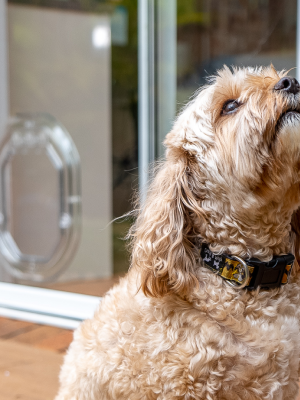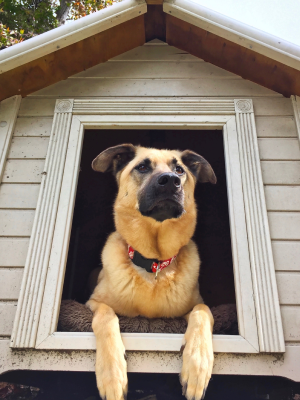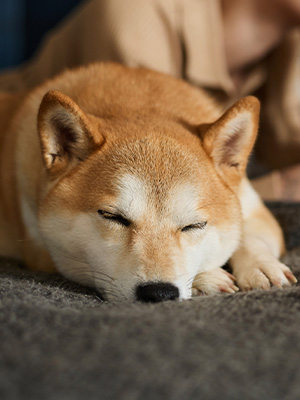
If you have ever noticed your dog making whimpering noises or leg movements during sleep, you might be wondering if they are dreaming. Research shows that dogs do, in fact, dream. Just like humans, dogs have similar sleep cycles, including REM sleep associated with dreaming. Read on to discover what dreams are, what your dog is dreaming about and what to do if a dog dreams.
Our Blog
Our Blog
31/7/25
Do Dogs Dream?
If you have ever noticed your dog making whimpering noises or leg movements during sleep, you might be wondering if they are dreaming. Research shows that dogs do, in fact, dream. Just like humans, dogs have similar sleep cycles, including REM sleep associated with dreaming. Read on to discover what dreams are, what your dog is dreaming about and what to do if a dog dreams.
What are Dreams?
Dreams are mental images or activity that occurs when we sleep. Both humans and animals have sleep cycles with stages from light sleep to heavy sleep and REM (rapid eye movement) sleep which is where most dreams occur. Like humans, dogs have REM sleep which is known for its most vivid dreams, explained by a significant increase in brain activity. During this state, the eyes move rapidly behind the eyelids and muscle movements can be involuntary.
What Do We Know About Dog Dreams?
What we know about dog dreams is that they are likely to go through the same sleep patterns and motions as humans. According to the Massachusetts Institute of Technology research, dogs can have complex dreams which can cause a variety of physical characteristics. Some of the findings show that:
- Most dogs tend to have sleep cycles that last about 20 minutes.
- For 6 of those minutes, the dog is likely in REM sleep and probably dreaming.
- When a dog is in REM sleep, breathing becomes shallow and muscles may twitch.
- During REM, the dogs’ eyes move behind the close lids.
- The dog may bark, whine, whimper, cry or make other sounds during REM sleep.
Why Do Dogs Dream?
Dogs dream to process emotions and memories in the same way that humans do. The brain activity noted during REM sleep in dogs indicates that they are dreaming with visual imagery and recreating events from during waking hours. The reasons dogs dream include:
- Processing their day: Dogs are thought to relive experiences during the day in dreams which helps them process their day. By dreaming about events during waking hours, dogs can reinforce what they have learnt during the day including new commands and tricks.
- Memory consolidation: Dreams help dogs consolidate memories which is the brain’s process of sorting out the important memories and discarding anything that is not useful. This is like a filing system for the brain where useful memories are stored away for future learning.
- Reliving their day: According to the continuity hypothesis, dreams reflect waking life so dogs relive their day when they dream. They may relive going for a walk, playing with toys or learning a new command. The twitching or running movement you might see them do during dreaming could be them reliving their day.
- Practice and learning: Dogs dream to reinforce things they have learned and practice new skills. Researchers believe they use that time to mentally rehearse learned behaviours.
What Do Dogs Dream About?
We can’t actually ask a dog what they dream about and yet scientists have established that canines are likely to dream during REM sleep. Like humans, dogs most likely dream about experiences in their lives, from happy to scary events. Dogs may dream about any of these things:
- Daily life and activities: Dogs dream about daily life like running around, chasing a ball, other dogs and people they have met during the day.
- Happy moments: Just like humans, dogs may dream about happy moments like being patted by their owner, playing with toys, or being cuddled.
- Scary moments: Dogs can have nightmares where they dream about scary moments which may be related to something traumatic, physical pain or anxiety.
- Breed specific things: There is some research that suggests specific breeds will dream about different things. Hunting dogs may dream about hunting, while herding dogs may dream about herding, for instance.
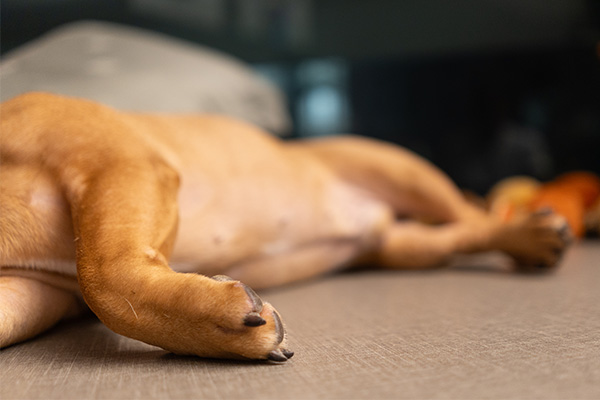
How To Tell if Your Dog is Dreaming
When a dog is in REM sleep, it is more likely to dream. You can tell a dog is dreaming by certain physical signs that occur during REM. These include:
- Leg moving or twitching: Twitching legs, paws and muscles are a sign of a dog dreaming, and indicate the brain is in a heightened state of activity. They may even look like they are trying to run, wag their tail or kick their legs during the dream state.
- Barking, whining or crying: Sometimes dogs may make noises like whining or barking during the dream stage. They are possibly reacting to something that is happening in their dream or reliving an experience from during the day.
- Breathing changes: When a dog is in REM it is not uncommon for their breathing rate to increase, become shallow or irregular. In addition to the breathing changes, the dog might whine, twitch or move their paws and legs as if running.
Factors that Affect Dog Dreams
There are a couple of things that can affect a dog’s propensity to dreaming. – breed and age being the two most common.
Breed
The dog’s breed can affect dreams. Smaller breeds like Chihuahuas or Toy Poodles tend to dream more often than larger breeds. However, their dreams may be much shorter. A small dog may dream every 10 minutes but the dreams may only last for a minute or less. Larger dogs like Great Danes or Labradors may only dream once every 60 to 90 minutes but the dreams may last for 5 to 10 minutes.
Age
A dog’s age definitely affects their dreaming. Senior dogs and puppies dream a lot more than middle aged dogs. This is because puppies have an underdeveloped pons which is a region in the brainstem that is crucial for initiating REM sleep and helping regulate the sleep/wake cycle. In senior dogs, the pons may be less efficient which impacts their REM sleep cycles and tendency to dream more. Puppies also dream more because they are rapidly learning and growing and have more information to process than adult dogs which they tend to do during REM sleep.
What To Do if Your Dog is Dreaming
It can be difficult to know whether to wake your dog if you see it is dreaming, particularly if it appears to be a bad dream. If you see your dog twitching or whining, it is highly likely they are dreaming but it may not necessarily be a bad dream. Dogs crying in their sleep can simply be a natural physical reaction to a dream even if it is a positive dream. While it may seem like your dog is in distress, it is always best to let them stay asleep. Like humans, if you wake a dog during sleep it can be disorientating and confusing. The dog may wake up and panic, or worse, bite or scratch. Getting a good sleep is essential for dogs to process what has happened during the day. Dreaming is a part of that natural routine and a normal part of their sleep cycle.
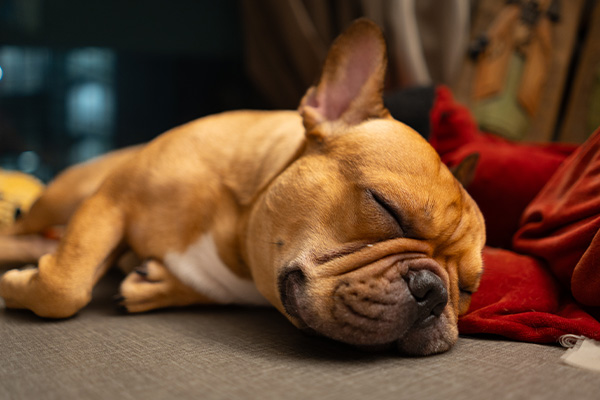
Dogs and Sleep Disorders
Just like humans, dogs can suffer from sleep disorders that can affect their dreaming. The most common sleep disorders in dogs are REM sleep behaviour disorder, narcolepsy, sleep apnea and insomnia. Any of these can disrupt normal sleep cycles and the dreaming that occurs during the REM state.
- REM Sleep Behaviour Disorder: This is a rare disorder characterised by dogs displaying violent motions and strange behaviour while asleep. During normal REM, the dog’s muscles become paralysed. However this does not occur in dogs with REM sleep behaviour disorder. Signs of REM sleep behaviour disorder include biting, howling, growling and chewing while asleep. The reason for this sleep behaviour disorder is not known but it is believed to start more in younger dogs. If a dog has REM sleep behaviour disorder it can disrupt the home environment and cause concern that the dog may injure itself during sleep. If this disorder is associated with another condition like tetanus, it can go away when the tetanus is cured. Otherwise, REM sleep behaviour disorder cannot be cured and is managed by controlling symptoms with medications.
- Narcolepsy: A relatively rare sleep disorder in dogs, narcolepsy can disrupt sleep patterns and dreams. Narcolepsy is characterised by excessive daytime sleepiness, collapsing during activities, and muscle weakness. A dog with narcolepsy will be excited and playing one moment and then pass out for a few seconds to a few minutes. While it is scary to witness, it is not life threatening. Dogs with narcolepsy may enter the REM state quickly and tend to have more vivid dreams that can lead to violent limb movements. Narcolepsy is not curable but can be managed with medications.
- Sleep Apnea: While sleep apnea is rare in most dogs, it is more likely to occur in brachycephalic (flat faced) dog breeds that have snouts that are short compared to the size of their head. When sleep apnea occurs, a dog may stop breathing during sleep for periods of time as the airway becomes smaller or blocked and reduces air to the lungs. Brachycephalic breeds like Pugs and French Bulldogs already have changes in their airways that make breathing difficult and are more prone to sleep apnea. This affects the dog’s ability to dream as they tend to wake up more during the night and are less likely to reach the REM sleep state where dreams occur.
- Insomnia: Some dogs may suffer from insomnia where they find it hard to go to sleep or stay asleep. This can lead to a lack of restful sleep and REM sleep cycles which impacts the ability to dream. Usually insomnia in dogs is due to an underlying health condition or behavioural cause like dementia, anxiety, pain, or excessive itchiness. Dogs with insomnia will usually pace and bark at night but be tired during the daytime. While insomnia is more common in older dogs with medical conditions, it can occur in some younger dogs with anxiety or allergies . To help a dog with insomnia, you can make sure they get exercise, provide a comfortable bed, and address any underlying causes or conditions.
Dogs do dream and there is scientific evidence to prove it. The brainwave patterns while dogs sleep and during REM are similar to those seen in humans when they are dreaming. When you notice your dog making noises or kicking in their sleep, it is highly likely they are dreaming. In this article, we have explained what dreams are, how to tell if your dog is dreaming and why dreams are necessary for a healthy pooch.
Latest Posts
Latest Posts
Questions? We’re here to help.

